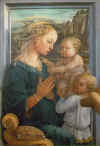Bible | Movies | Books | People | Hot Topics | Holidays | Humor | Gallery | Sanctuary | Sermons | Prayer | Quizzes | Communities | God | FAQ | Links
|
Sponsored Link |
This Madonna is a case in point. Her face appears on the canvas in a near profile view, allowing the artist to emphasize her hair, entwined with pearls. She is facing the Christ child and the two angels to the lower right. All three of these figures look charmingly realistic, like actual children, rather than the merely generic figures in most earlier Christian paintings. Especially charming is the angel in the lower right who seems to be so pleased with himself, holding the Savior aloft, so he can reach out and touch his mother. Depicting a scene of apparent innocence, this painting figures as part of a major scandal. Soon after it was completed, word began to circulate that the model for the Madonna was Lucrezia Buti, a beautiful nun with whom the friar was scandalously in love. Friar Lippi later gave up his ordination to marry Lucrezia, which will strike most contemporary readers as a happy ending to the story, but one which does not answer the fascinating questions raised by the notorious love affair. Does it in any way diminish the value of this work, that in painting the Virgin Mary the artist was inspired by a passion that many would describe as sinful? My own feeling would be that it does not. While this may be a somewhat extreme illustration of the point, it seems to me that human motives are never entirely pure. In most things we do there is a mixture of different, often conflicting impulses. Let's face it: human life is messy. The human race cannot be divided neatly into two camps: the good and the evil. Rather, the evil and the good are inextricably intertwined into the warp and woof of all that we do. Even if friar Lippi had not been involved in a love affair with the beautiful Lucrezia, his work might still have been inspired as much by vanity as by piety, and as much by the desire to please his powerful patrons in Florence, as by a simple love of God. Still, there has been a tendency, in some quarters to dwell upon the friar's faults. For example, The Catholic Encyclopedia practically demonizes him in these words: "The great artist lived in the continual embarrassments caused by his deplorable morals. Never was anyone less fitted for religious life. His portraits show us a flat-nosed individual with a jesting, but vicious looking, thick-lipped, sensual face. To compel him to work Cosmo de Medici (his sponsor and benefactor) was forced to lock him up, and even then the painter escaped by a rope made of his sheets. His escapades threw him into financial difficulties from which he did not hesitate to extricate himself by forgery. ... At length, despite his evil reputation, Lippi succeeded in having himself appointed chaplain of a congregation of Augustinians. Here his misbehaviour was no less flagrant than elsewhere. It is significant and shows plainly what were the ideas of the Renaissance that Lippi was not punished for his bad conduct. Glory or genius then constituted a soil of privilege and a warrant of impunity. Talent placed its possessor beyond and above the moral law. Not only did Cosmo de Medici make merry over what he called the "folly of the frater," but Pope Pius II thought he could do no better than to release him from his vows and permit him to marry. A son, Filippino Lippi, had already been born to him. He afterwards had a daughter (1465). In the midst of these intrigues and disorders Filippo continued to paint his greatest works." Clearly the editors of this encyclopedia treat Lippi as the very symbol of an entire culture which they despise, suggesting that Lippi embodies the very worst evils of the Italian Renaissance. But, alas, there is another way of looking at this situation entirely. Rather than seeing Lippi as unfit for the "religious life," largely because he happened to fall hopelessly in love with his Lucrezia, why not recognize that his creativity and success as an artist may spring in part from the fact that he dared to resist the confines of the monastery and risk entering into a loving relationship with another human being? He broke his vows of celibacy, to be sure, but his love of life in general and of this one woman in particular inspired a lifetime of creativity that in the end allowed him to give expression to the beauty of the Christian tradition in ways that more obedient folk seldom dream of. This is not to say that in order to become either a great artist
or an inspired Christian one should make rebellion and rule breaking a way of
life. Rather, this entire story illustrates why it is that Christians, at their
best, tend to emphasize grace rather than good works. Grace being the means by
which God can bring beauty and goodness out of the compromised situations in which
we normally find ourselves. "We know that in everything God works for the
good," wrote St. Paul. This was not an expression of naive optimism, nor
a failure on Paul's part to treat evil as a serious force in the world or even
his own life. On the contrary, it reflects his realization that the very best
things in life are in large part a gift. Recognizing that life itself is a gift
from God, one of the natural results is to want to celebrate and share. This is
what the errant monk, Filippo Lippi, did to a remarkable degree. More on Christianity and the arts
Please take a moment to let us know you
were here!
If you want to talk with someone in person, please feel free to call 917-439-2305
The Rev. Charles P. Henderson is a Presbyterian minister and is the author of God and Science (John Knox Press, 1986). Charles also tracks the boundry between the virtual and the real at his blog: Next World Design, focusing on the mediation of art, science and spirituality in the metaverse. For more information about Charles Henderson. |
Sponsored Link
|


